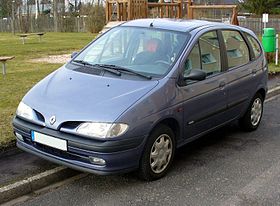Renault Scenic
| Renault Scénic | |
|---|---|
 |
|
| Overview | |
| Manufacturer | Renault |
| Also called | Renault Mégane Scénic (1996–1999) Renault Grand Scénic (2004–present) |
| Production | 1996–present |
| Body and chassis | |
| Class | Compact MPV (M) |
| Body style | 5-door MPV |
| Layout | Front-engine, front-wheel-drive or four-wheel-drive |
| Mégane Scénic & Scénic I | |
|---|---|

1996–1999 Renault Mégane Scénic
|
|
| Overview | |
| Also called | Beijing Fengjing (BJ6410) |
| Production | 1996–2003 |
| Body and chassis | |
| Related | Renault Mégane I |
| Powertrain | |
| Engine | 1.4 L I4 (petrol) 1.4 L 16-valve I4 (petrol) 1.6 L I4 (petrol) 1.6 L 16-valve I4 (petrol) 2.0 L I4 (petrol) 2.0 L 16-valve I4 (petrol) 1.9 L D I4 (diesel) 1.9 L dT I4 (diesel) 1.9 L dTi I4 (diesel) 1.9 L dCi I4 (diesel) |
| Transmission | 5-speed manual 4-speed automatic |
| Dimensions | |
| Wheelbase | 2,580 mm (101.6 in) (Mégane Scénic, Scénic) 2,624 mm (103.3 in) (Scénic RX4) |
| Length | 4,168 mm (164.1 in) (Mégane Scénic, Scénic) 4,444 mm (175.0 in) (Scénic RX4) |
| Width | 1,719 mm (67.7 in) (Mégane Scénic, Scénic) 1,785 mm (70.3 in) (Scénic RX4) |
| Height | 1,609 mm (63.3 in) (Mégane Scénic, Scénic) 1,730 mm (68.1 in) (Scénic RX4) |
| Scénic II | |
|---|---|
 |
|
| Overview | |
| Production | 2003–2009 |
| Assembly | Douai, France (Douai Factory) |
| Body and chassis | |
| Related | Renault Mégane II |
| Dimensions | |
| Wheelbase | 2,685 mm (105.7 in) (Scénic) 2,736 mm (107.7 in) (Grand Scénic) |
| Length | 4,259 mm (167.7 in) (Scénic) 4,493 mm (176.9 in) (Grand Scénic) |
| Width | 1,811 mm (71.3 in) |
| Height | 1,621 mm (63.8 in) (Scénic) 1,641 mm (64.6 in) (Grand Scénic) |
| Scénic III | |
|---|---|
 |
|
| Overview | |
| Production | 2009–2016 |
| Assembly | Douai, France (Douai Factory) |
| Body and chassis | |
| Related | Renault Mégane III |
| Powertrain | |
| Engine | 1.2l H5Ft I4 petrol 1.5l K9K I4 dCi FAP diesel 1.6l R9M I4 dCi FAP diesel 1.9l F9Q l4 dCI FAP/non-FAP diesel |
| Dimensions | |
| Wheelbase | 2,700 mm (106.3 in) (Scénic) 2,769 mm (109.0 in) (Grand Scénic) |
| Length | 4,343 mm (171.0 in) (Scénic) 4,559 mm (179.5 in) (Grand Scénic) |
| Width | 1,844 mm (72.6 in) |
| Height | 1,636 mm (64.4 in) (Scénic) 1,643 mm (64.7 in) (Grand Scénic) |
| Scénic IV | |
|---|---|
 |
|
| Overview | |
| Production | 2016-present |
| Body and chassis | |
| Platform | Renault–Nissan Common Module Family CMF-CD |
| Related | Renault Espace V |
| Powertrain | |
| Transmission | |
| Dimensions | |
| Wheelbase | 2,734 mm (107.6 in) 2,804 mm (110.4 in) (Grand Scénic) |
| Length | 4,406 mm (173.5 in) 4,634 mm (182.4 in) (Grand Scénic) |
| Width | 1,865 mm (73.4 in) 1,865 mm (73.4 in) (Grand Scénic) |
| Height | 1,653 mm (65.1 in) 1,660 mm (65.4 in) (Grand Scénic) |
The Renault Scénic is a compact multi-purpose vehicle (MPV) produced by French automaker Renault, the first to be labelled as such in Europe. It is based on the chassis of the Mégane small family car. It became the 1997 European Car of the Year on its launch in late 1996. The second and third generations have a model called Grand Scénic, which has 7 seats rather than 5.
The Mégane Scénic can be traced back to a concept car designed under the supervision of Anne Asensio, then designer at Renault.
The Scénic was mechanically identical to the Mégane hatchback (itself based on the older R19). The 1.4 L, 1.6 L "Energy", 1.8 L "F-type" petrol and 1.9 L diesel engines were shared with the hatchback range. The Scénic was marketed as a multi-purpose vehicle, in a smaller size lower price of such vehicles as Renault's own Espace. Renault underestimated the market demand that the Scénic would have—predicting that it would be a niche model with only 450 produced a day. Production at the company's Douai plant would eventually peak at nearly 2,500 cars a day.
Along with the Mégane hatchback, the Scénic underwent a minor frontal restyle in 1999 and the newer 16-valve engines introduced. The front end was quite a bit different from the Mégane counterpart, and there were also redesigned rear lights. From the time of this restyle, it became officially known as the Renault Scénic, although a small "Mégane" badge still appeared on the rear door signifying the car's origin. This model was built in Brazil with flexible fuel engines.
The Phase 2 allowed the Scénic to be separate from the Mégane and its predecessor by introducing improvements such as a storage compartment on the dashboard, and a separate opening rear window on the tailgate. Another small improvement with the Scénic were the rear head restraints which were fixed over the back of the seat rather than being upright. This increased rear visibility.
...
Wikipedia
